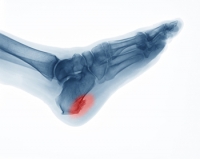
A heel spur is essentially a hook-shaped bony formation that can sometimes develop on the underside of an individual’s heel bone. The spur will grow and point toward the toes of the foot. Interestingly, there has been some debate within the scientific community about the exact etiology, or cause, of heel spurs. For example, one’s hereditary propensity towards heel spurs was thought to be a contributing factor to the development of heel spurs. Today, it is primarily thought that excessive pronation is the main culprit for heel spurs. Overpronation is associated with unnatural biomechanics of the feet. This is all to say that excessive pressure or an awkward way of moving the feet when engaging in physical activity can contribute significantly to the development of heel spurs. Consider contacting a podiatrist today for more information about heel spurs and for any treatment that you might need.
Heel spurs can be incredibly painful and sometimes may make you unable to participate in physical activities. To get medical care for your heel spurs, contact Dr. Kenneth Donovan from Advanced Care Foot and Ankle. Our doctor will do everything possible to treat your condition.
Heels Spurs
Heel spurs are formed by calcium deposits on the back of the foot where the heel is. This can also be caused by small fragments of bone breaking off one section of the foot, attaching onto the back of the foot. Heel spurs can also be bone growth on the back of the foot and may grow in the direction of the arch of the foot.
Older individuals usually suffer from heel spurs and pain sometimes intensifies with age. One of the main condition's spurs are related to is plantar fasciitis.
Pain
The pain associated with spurs is often because of weight placed on the feet. When someone is walking, their entire weight is concentrated on the feet. Bone spurs then have the tendency to affect other bones and tissues around the foot. As the pain continues, the feet will become tender and sensitive over time.
Treatments
There are many ways to treat heel spurs. If one is suffering from heel spurs in conjunction with pain, there are several methods for healing. Medication, surgery, and herbal care are some options.
If you have any questions feel free to contact one of our offices located in Warren, Livingston, and Toms River, NJ . We offer the latest in diagnostic and treatment technology to meet your needs.

